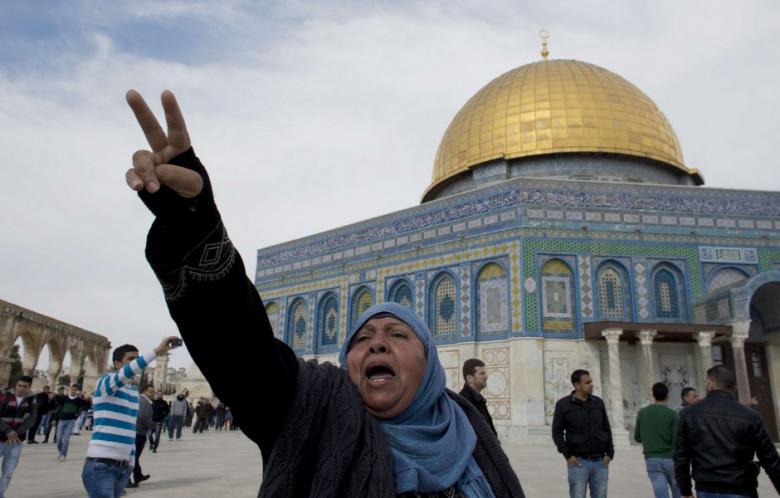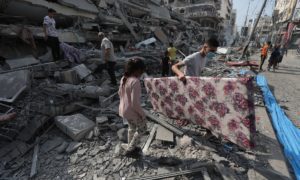On October 7, the world witnessed a deadly barrage of rockets and fighters sent into southern Israeli territory by the Palestinian resistance group, Hamas. This has been followed by 900 reported deaths in Israel and more than 770 in Gaza, according to the latest reports.
Hamas’ military leader, Mohammed Deif, explained that 5,000 rockets were launched in what he termed “Operation Al-Aqsa Flood,” declaring, “we’ve decided to say enough is enough.” Hamas said this was a response to Israel’s criminal occupation of the West Bank, recent Israeli police raids and desecration of the Al-Aqsa Mosque in Jerusalem, and the mistreatment of Palestinian prisoners in Israeli jails.
In response, Israel declared a “state of war,” unleashing air attacks and shelling that displaced over 123,538 Palestinians in Gaza, as reported by the UN humanitarian relief agency. Most areas are without electricity as Israel has stopped supplying Gaza with power. Food and water supplies have also been cut.
While the attack by Hamas captured global attention, the underlying tensions were no revelation, echoing the deeply rooted historical, religious, and geopolitical dynamics surrounding the occupation of Palestine by Israel.
Historical Context
The conflict between Israel and Palestine is often simplified as a binary of Muslims versus Jews, reflecting the intricate historical dynamics of the two Abrahamic regions. In Jewish history, Jerusalem served as the capital during King David’s reign, hosting highly sanctified sites like the Temple Mount and the Western Wall.
Conversely, in Islamic history, the city holds significance as the first Muslim Qiblah and the site of Prophet Muhammad’s famous night journey.
However, this conflict is far from a simple religious clash. In the Middle East, where Judaism, Islam, and Christianity emerged, centuries of coexistence under the Ottoman Empire saw relative peace.
The dynamics shifted in the late 19th and early 20th centuries with the rise of Zionism and British colonialism, paving the way for the complex geopolitical landscape today.
Zionism and the Birth of Israel
Zionism, a religious and political movement, drew thousands of Jews to Palestine, establishing Israel as the central location for Jewish identity. Originating in Europe in the late 19th century, Zionism found roots in the historical connection between Judaism and Palestine.
Facing discrimination and persecution in Europe, Jews sought safety by establishing their own state, choosing Palestine. However, this aspiration collided with the presence of an Arab majority that had inhabited the region for centuries.
Balfour Agreement : Promises Compromised
A pivotal moment in the modern history of the region occurred with the dissolution of the Ottoman Empire. In 1917, the British government announced the Balfour Declaration, hoping to gain Jewish support for World War I, which promised: “the establishment in Palestine, a Jewish support for World War I, which promised: “the establishment in Palestine, a national home for the Jewish People”.
However, just two years ago, Britain made another promise to the Arabs living in the region that Palestine was going to be a part of an independent Arab state after the war was over. The growing Jewish Settler population in Palestine heightened tensions with the Arab communities already wary of British plans.
In the 1930s, British rule attempted to navigate this complex web by limiting Jewish immigration to Palestine. This period saw the rise of Jewish militias fighting against Arabs and British rule. After the tensions escalated further, the British decided to leave what had become a mess. And this was just the beginning of Israel’s occupation of Palestine.
1948: The First Arab-Israeli War
In 1947, Britain decided to refer the matter to the United Nations as the violence escalated in the region. The United Nations decided to form a Special Committee On Palestine – UNSCOP. This committee went to Palestine, talked to people, made some investigations, and they came up with a plan.
This partition plan said that there were going to be two states in Palestine – a Jewish state and a Palestinian state.
This plan was not accepted by Arabs in Palestine because even though only a third of the population was Jewish and the Jews owned only 10% of the land in Palestine, they were given 55% of the territory. The Palestinians ended up with 45%, even though they were the majority at the time.
The United Nations’ decision to partition the British mandate of Palestine into Jewish and Arab states ignited the Arab-Israeli War in 1948. Arab states, including Jordan, Egypt, Syria, Lebanon, and Iraq, invaded Israel.
The war concluded in 1949 with a ceasefire, resulting in territorial gains for Israel beyond the UN plan, with Israel gaining 80% of the designated territory and the displacement of Palestinian Arabs. The lack of a peace agreement set the stage for subsequent conflicts, accompanied by the establishment of Israeli settlements in Palestinian territories.
On May 14, 1948, Israel officially declared its independence, with the United States being the first country to recognise it. As of 2020, a significant majority of the 193 UN member states, including some Arab nations like the UAE and Bahrain, formally acknowledge Israel’s existence.
Struggle for Land and Rights
In the present scenario, the Palestinian territories, including the Gaza Strip, West Bank, and East Jerusalem, remain under an illegal Israeli occupation. Since 1967, Israel has been destroying Palestine homes, driving the populace out into refugee camps and rebuilding houses and moving Jewish settlers into these territories.
As of May 18, 2021, an Al Jazeera report notes that about 1.6 million Palestinians holding Israeli citizenship face systemic discrimination within present-day Israel. These Palestinian communities grapple with violence, movement restrictions, and limited access to essential resources in a territory that belonged to them.
Who are Hamas?
Central to the current escalation is Hamas, the largest Palestinian militant group, governing over two million Palestinians in the Gaza Strip.
It was formed in the late 1980s during the first Palestinian intifada, a period of mass, civilian-based, unarmed resistance against the Israeli occupation.
Hamas opposed the Oslo Peace Accords, which aimed to establish limited Palestinian self-rule in parts of the Gaza Strip and the West Bank. The group’s concerns revolved around potential compromises on the right of Palestinian refugees to return to lands seized in 1948.
Hamas as a whole, or in some cases its military wing, is designated a “terrorist group” by the US, the European Union and the UK—as all stand united in funding Israel.
Palestinian Resistance so Far
For decades, people in Gaza have faced severe restrictions on their movement, living in an open-air prison.
Israeli-controlled checkpoints allow limited exit for work or critical medical reasons. Even going to the West Bank requires special permissions. In this challenging situation, with 1.84 million Palestinians, or one-third of the population, experiencing food shortages, mostly in Gaza, where 90 percent of 1.1 million face severe food insecurity, they persist.
The recent actions by Hamas in Gaza, a significant response by Palestinians, are an inevitable response against suffering, blockade, and occupation. Despite knowing the risks, Palestinians resist, as Enas Wajeeh Qeshta, a Gaza resident, told Al Jazeera: “It was a tough night. We were waiting for our destiny… There’s no safe haven. Everyone is targeted.”












